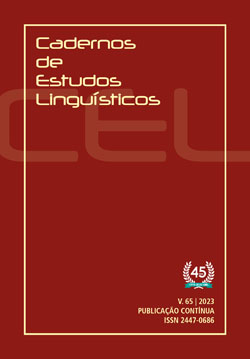Abstract
This article describes some of the textual properties of musical albums from the semiotic point of view, aiming at demonstrating how songs as record tracks constitute objects of investigation that are different from a song by itself. Firstly, enunciative practices typical to albums (especially the selection and sequencing of tracks) are discussed, bringing forth the tension that they establish between, on one side, the autonomy of tracks and, on the other, the album’s sense of unity. Next, the concept of analysis as proposed by Louis Hjelmslev is evoked in order to provide criteria for the description of the relations between a given ensemble (a class) and its parts (components). These considerations serve as basis for the description of the song “É doce morrer no mar” as a component of the class Canções praieiras, first album launched by Dorival Caymmi. Both instances exert influence on each other: while the song gives voice to the woman from the beachside community, who expresses her resignation, the collection of tracks as an ensemble manifests the values of the beachside community and creates a deep sense of sufficiency which justifies the woman’s resignation. Thus, even by working strictly with the verbal component, the corpus illustrates the interdependence between album and track in the generation of meanings typical to this textual totality.
References
ACEITAÇÃO. Grande dicionário Houaiss, 2017. Disponível em: https://houaiss.uol.com.br. Acesso em: 3 ago. 2017.
BADIR, Sémir. Figures épistémologiques de la fragmentation. In: Des écritures fragmentaires. Question d’énonciation. Congrès de l’Association Française de Sémiotique. Lyon, 2-4 dez. 2010. 2011. Lyon. Disponível em: http://hdl.handle.net/2268/170311. Acesso em: 13 abr. 2019.
BUARQUE, Chico. Construção. Rio de Janeiro: Philips, 1971. 33 ⅓ rpm, microssulco, estéreo. 33340-1.
CAYMMI, Dorival. Canções praieiras. Rio de Janeiro: Odeon, 1954. 33 ⅓ rpm, microssulco, estéreo. 3.004.
FIORIN, José Luiz. As astúcias da enunciação: as categorias de pessoa, espaço e tempo. 3 ed. São Paulo: Contexto, 2016.
GREIMAS, Algirdas Julien; COURTÉS, Joseph. Dicionário de semiótica. Trad. Alceu Dias Lima et al. São Paulo: Contexto, 2016.
HJELMSLEV, Louis. Prolegômenos a uma teoria da linguagem. Trad. J. Teixeira Coelho Netto. São Paulo: Perspectiva, 1975.
LEMOS, Carolina Lindenberg. Condições semióticas da repetição. 2015. Tese (Doutorado em Semiótica e Linguística Geral) – Faculdade de Filosofia, Letras e Ciências Humanas, Universidade de São Paulo, São Paulo, 2015.
LEMOS, Carolina Lindenberg. O percurso na circularidade: estudo da emoção na letra, na música e na voz, Todas as letras, São Paulo, v. 25, n. 2, ago. 2023 (no prelo).
MAFRA, Matheus Henrique. Um álbum de canções: reflexões semióticas sobre Canções Praieiras. 2019. Dissertação (Mestrado em Semiótica e Linguística Geral) – Faculdade de Filosofia, Letras e Ciências Humanas, Universidade de São Paulo, São Paulo, 2019.
MAMMÌ, Lorenzo. A era do disco, Piauí, n. 89. São Paulo: Abril, 2014.
MOLINA, Sidney. O violão na era do disco: interpretação e desleitura na arte de Julian Bream. 2006. 335f. Tese (Doutorado em Comunicação e Semiótica) - Pontifícia Universidade Católica. São Paulo, 2006.
MOLINA, Sergio. Música de montagem: a composição de música popular no pós-1967. São Paulo: É Realizações, 2017.
O'HAGAN, Steve; BARBOUR, Hamish. When albums ruled the world [Filme-Vídeo]. Produção de Hamish Barbour, direção de Steve O'Hagan. Londres, BBC Four, 2013. 90 min. color. Son.
REGINA, Elis; JOBIM, Tom. Elis & Tom. Rio de Janeiro: Philips, 1974. 33 ⅓ rpm, microssulco, estéreo. 6349112.
RESIGNAÇÃO. Grande dicionário Houaiss, 2017. Disponível em: https://houaiss.uol.com.br. Acesso em: 3 ago. 2017.
SARAIVA, José Américo Bezerra. A identidade de um percurso e o percurso de uma identidade: um estudo semiótica das canções do Pessoal do Ceará. Fortaleza: Edufc, 2013. Disponível em: https://repositorio.ufc.br/bitstream/riufc/10239/3/2013_liv_jabsaraiva.pdf. Acesso em: 14 jul. 2022.
TATIT, Luiz. O século da canção. São Paulo: Ateliê, 2004.
ZILBERBERG, Claude. Elementos de semiótica tensiva. Tradução de Ivã Carlos Lopes, Luiz Tatit e Waldir Beividas. São Paulo: Ateliê Editorial, 2011.
ZILBERBERG, Claude. La structure tensive suivi de Note sur la structure des paradigmes et de Sur la dualité de la poétique. Liège: PULg, 2012.

This work is licensed under a Creative Commons Attribution-NonCommercial 4.0 International License.
Copyright (c) 2023 Cadernos de Estudos Linguísticos


